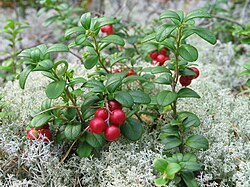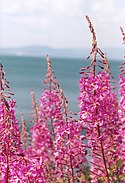Floristic regions in Europe (english)
- The central european region and the central russian region are sister regions. The border between them is similar to the Fagus sylvatica limit (January, day-time temperature average: above -2°C).
- The border between the central russian region and the boreal region is similar to the Quercus spp. limit (Day-time temperature average: above 10°C, 4 months per year).
- The border between the boreal region and the arctic region is similar to the tree line, taiga/ arctic tundra limit (July, day-time temperature average: above 10°C).
- The border of the atlantic region is the limit of no frost (average), Gulf Stream influence.
- The warm islands in the Atlantic ocean are in the macaronesia region: isolated populations in a more humid environment.
- The mediterranean region is similar to the occurrence of wild Olea europea and wild Cistus salviifolius (Olea europea is grown very North in Italy).
- The border between the submediterranean region and the central european region is similar to the alpine arc (upper Rhone, upper Rhine, lower Danube), a weather barrier.
- The pontic region border is similar to the tree line/ steppe limit (less than 450 mm precipitation per year).
- The turanian region has a semi-arid climate.
- References:
- Frey W, Lösch R (2004) Lehrbuch der Geobotanik. Elsevier, Spektrum; München, Heidelberg; ISBN 3-8274-1193-9 (graphic modified from Walter H (1954) Grundlagen der Pflanzenverbreitung. Einführung in die Pflanzengeographie, II. Teil: Arealkunde. Ulmer, Stuttgart-Ludwigsburg)
- Frey W, Lösch R (2010) Geobotanik: Pflanzen und Vegetation in Raum und Zeit. 3 ed, Spektrum, Heidelberg, ISBN 978-3-8274-2335-1
Relevantní obrázky
Relevantní články
Fytogeografické členění EvropyFytogeografické členění Evropy je rozdělení evropských květenných oblastí dle jejich typických prvků na základě podnebí, teploty, vlhkosti, rozložení srážek, zeměpisné šířky a kontinentality, přičemž nejdůležitější jsou zde dva ekologické gradienty: směrem od severu na jih roste průměrná teplota a délka vegetačního období, směrem od západu na východ roste kontinentalita, tedy teplotní rozdíly mezi zimou a létem. Lze rozlišit několik hlavních oblastí, jimž odpovídají typické elementy flóry a vegetační typy. .. pokračovat ve čtení
Cirkumboreální oblastCirkumboreální oblast ve fytogeografii je floristický region uvnitř boreální říše v Eurasii a Severní Americe, jak ji vymezili geobotanikové jako byli Josias Braun-Blanquet a Armen Tachtadžjan. .. pokračovat ve čtení





